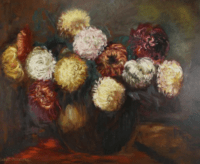Rudolf Nitschke
Rudolf Nitschke (February 5, 1903 – June 2, 1961)
Rudolf Nitschke was a German painter who was born in Dresden on February 5, 1903. He was the son of the civil servant Richard Nitschke and his wife Ida. After attending elementary school, he completed an apprenticeship as a precision mechanic. Between 1927 and 1929, he was a private student at Ewald Schönberg’s painting school in Dresden. From 1931 to 1937, he studied at the Academy of Fine Arts in Dresden under the renowned professors Richard Müller, Hans Hanner and Otto Dix, with whom he eventually became a master student.
When the Nazis began to remove Dix from the academy in 1933, Nitschke was one of a group of seven students who wrote a letter to the National Socialist Student Association in support of Dix on March 15, 1933. He completed his studies in 1937 as a qualified painter.
In 1938, Nitschke moved from Dresden to Württemberg, first to Balingen and later to Spaichingen. During the first years of the war, he worked as a stage manager at the Freiburg theater. Towards the end of the war, he was drafted into the army and sent to Russia as a medical orderly. He returned from captivity as a prisoner of war in 1946.
After the war, he opened a painting school in Spaichingen. Together with his wife Elli-Maria and painting student Hannel Illg, he organized a touring exhibition with which they travelled through the region. However, the idea of a joint southern German artists’ association failed. In 1951, the artist moved to Villa Rössle in Balingen.
Rudolf Nitschke died on June 2, 1961 in Hößlinswart (Schorndorf).
Rudolf Nitschke was a versatile and accomplished artist. In addition to landscape painting “en plein air”, he devoted himself in particular to portraiture. He acquired a sound knowledge of drawing and composition during his studies at the academy. He also studied the panel paintings of the Old Masters in the Royal Picture Gallery in Dresden and made copies. At the same time, he experimented with a complicated multi-layer glazing technique and special “stand oils” – paints that had to rest for several weeks before use. The influence of his professor Otto Dix was also clearly visible in his early works, especially in his nude drawings, which strove to depict reality without a flattering or idealizing view of the sitter.
In the course of his life, Nitschke expanded his stylistic repertoire. His numerous oil paintings of the Swabian landscape radiate an impressionistic lightness and luminosity. Study trips provided him with new inspiration for his other works. As a well-known and respected portrait painter, he frequently received commissions from political and cultural figures during this period. Another focus of his work was large-format floral still lifes. He also restored damaged oil paintings from public collections.
In addition to the oil paintings, the painter often created small-format etchings that dealt thematically with the region.
On October 27, 1931, he married Elli-Maria Kretschmar. They had four children. In 1960, he married Hannel Illg (1923-2018) for the second time. Hannel Nitschke-Illg inherited his artistic estate and bequeathed it to the town of Balingen. His donation included 60 oil paintings, four pastel drawings, around 45 charcoal drawings and 25 etchings, which were incorporated into the municipal art collection.
Showing the single result
-
Rosen Stillleben | Gemälde von Rudolf Nitschke
Rudolf Nitschke (1903 – 1961)

